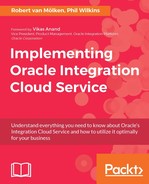In this chapter we looked at how ICS provides the means to perform a powerful level of orchestration when creating an integration. We first explained the high-level differences from the integrations we have built up so far. We reused a few connections we built in earlier chapters, but also created a new connection to the SaaS application Trello, which is a Jira-style application. We also updated the existing REST API available at Apiary.io. After the initial setup we started building our orchestration and granularly made the process more intelligent. We first looked at the different UI and workflows, compared the basic map data integrations, and explained the available actions, which ranged from simple to more advanced functionality. To give you a basic feel for creating an orchestration, the more common actions were introduced, for example, assign, switch, and branches. Because of the different routes we implemented, we then needed to test the orchestration extensively. Using the given SoapUI project we tested all test cases, each with a different outcome.
In the next chapter, we will look at the underlying factors that can drive the need to connect with on-premise applications and the need to use an agent with ICS to connect to these applications. We will look at the solution ICS provides in the form of an agent and show you how to install and use the agent in combination with an on-premise ERP database.
